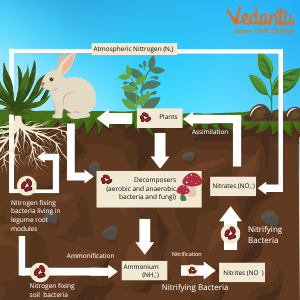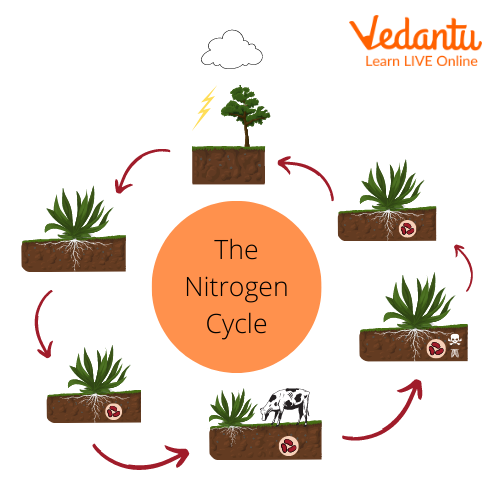




Introduction to Nitrogen Cycle
The nitrogen cycle is a hydrologic cycle by which nitrogen is translated into different chemical forms as it flows among the atmosphere, terrestrial and oceanic ecosystems. The transformation of nitrogen can be carried out through both biological and physical processes.
Nitrogen is a key nourishing element for plants. Even so, the generous nitrogen in the atmosphere cannot be used directly by plants and animals. The nitrogen cycle makes the utilisation of nitrogen available to plants and other living organisms. Jules Rieset admitted in 1856 that decomposing organic matter releases nitrogen. This location ultimately provided the basis for the nitrogen cycle because it was the first proof of nitrogen cycling in the biological sphere.
The Nitrogen Cycle
The nitrogen cycle expresses how nitrogen works between plants, animals, bacteria, the atmosphere or air, and soil in the ground. It is an essential part of all life on earth. We can remember the nitrogen cycle by the picture ourselves a couple of times, try to make up a story about the diagram that the plant begins to use nitrogen, then the decomposes get in the act, and so on. When a nitrogen generator builds nitrogen gas, the generator does not create nitrogen by itself. Preferably, nitrogen gas present in the air is purified inside the generator.

Nitrogen Cycle Diagram
Why are Bacteria a Necessary Part of the Nitrogen Cycle?
One of the most essential parts of the nitrogen cycle is bacteria. Bacteria help the nitrogen cycle substitute between states so it can be used. When nitrogen is soaked by the soil various bacteria help it to change states so it can be soaked by the plants. Animals then get their nitrogen from the plants.
Nitrogen enters the living universe by way of bacteria and other individual celled prokaryotes which invert atmospheric nitrogen into biologically usable forms. Bacteria are free-living in soil or water. Small microscopic organisms with single cells are called bacteria, they are important for ecosystems as they play a major role in the biochemical process. Bacteria change nitrogen gas from the atmosphere to nitrogen compounds that the plants can soak. That’s why bacteria is a necessary part of the nitrogen cycle.
Nitrogen Cycle Steps
In general, there are five steps of the nitrogen cycle which are as follows:-
Nitrogen Fixation:- Nitrogen must be stable in order to be used by plants
Nitrification:- For those plants who refuse to resolve with Ammonia.
Assimilation:- It is when plants mop up the substances fall asleep by nitrogen fixation and Nitrification.
Ammonification:- Ammonia is made by decaying bacteria.
Denitrification:- If the nitrate ions choose not to combine they depart from the soil and are inverted by limited anaerobic bacteria in water-logged soil and lakes.

Nitrogen Cycle Steps
What is the Role of Bacteria in the Nitrogen Cycle?
Bacteria play a medium role in the nitrogen cycle by the following points:-
Nitrogen-fixing bacteria, change atmospheric nitrogen to nitrates.
Bacteria decompose, which changes decomposing nitrogen waste to ammonia.
Nitrifying bacteria, change ammonia to nitrates.
Denitrifying bacteria, which change nitrates to nitrogen gas.
Fungi-like bacteria help to translate dead plants and animals and their misuse into ammonia in the soil. Plants soak up nitrates from the soil to make proteins. Animals absorb plants and use them to form animal protein.
Summary
In this, we talked about the nitrogen cycle, how it is formed, some best examples, some steps of the nitrogen cycle, and how bacteria play a vital role in the nitrogen cycle. It is better explained by the diagrams.
FAQs on Nitrogen Cycle
1. Why do plants need nitrogen?
Plants need nitrogen as this part is an essential component of chlorophyll. As a result, chlorophyll is important for the process of photosynthesis so the absence of nitrogen can cause shortage disorders such as growth and other abnormalities. It is the mixture by which plants use sunlight energy to produce sugars from water and the carbon dioxide that is photosynthesis It is also a major component of amino acids, the building pieces of protein. Without protein, plants become limp and die.
2. What is the process where plants use nitrates to grow?
The process where plants use nitrates to grow is nitrification. Elements such as ammonia, ammonium, nitrites, and nitrates can be absorbed from soils by plants and then used in the origination of plant and animal proteins. It is negotiated by nitrifying microorganisms like Nitrosomonas and Nitrobacter. It includes the turning of reduced nitrogen species into oxidised nitrogen species. The end of the product of Nitrification is nitrate. It is functional for plants for nitrogen fixation. It requires an aerobic condition.









